Beets are a common agricultural culture that is often found in the garden. It is grown not only for cooking, this vegetable is ideal as animal feed, saturating their body with useful components.
Contents
- What fertilizers to use when planting beets?
- Basic recommendations for the landing of beets
- Scheme and features of spring planting beets
- Scheme and features of autumn planting beets
- How to leak beets?
- Features of beet care after planting
- The best varieties of beets for open ground
- Video: Subtleties of beet planting in open ground
From this article you will learn what to add to the hole when planting beets, as well as the main scheme for planting a culture.
What fertilizers to use when planting beets?
To collect a good harvest, you will need to prepare the following fertilizers when planting beets:
- Nitrogen. If the plant does not receive a sufficient amount of this component, yield indicators will decrease, and the green mass will form pale. An excess of substance leads to the dummy of the root crop and the development of brown rot. If there is a lot of nitrogen in the soil, the ripening timing will increase. It is recommended to add no more than 30 g of nitrogen fertilizers to each hole.
- Phosphorus. This element is necessary for the development of the rhizome. The fruits will turn out more juicy, sweet and large. A sufficient amount of phosphorus will reduce the likelihood of flowering, and strengthen the immune system of culture. Beets will be more resistant to frost, especially if you carried out an early landing. Bend 30-40 g of superphosphate to each hole.
- Potassium. For the culture to confront drought and diseases, it is necessary to add 15 g of potassium nitrate to each hole. This element increases the terms of culture. It is recommended to increase the amount of potassium to 20 g in case of planting beets on peat soils.
- Bor. If the culture does not receive a sufficient amount of boron, the foliage will be small, the ground part will slow down in development, and the core of beets will be covered rotten. Bring 15 g of boron to each hole, especially if you plant a culture in sod-podzolic soil. If excess lime in the ground, boron will become poorly absorbed.
- Manganese. The deficiency of this substance negatively affects the sugarness of the fruit. If you grow beets on peat, carbonate, sour lime soils, bring 5 g of manganese to each hole. You can make a nutrient solution (1/3 tsp. Manganese per 10 liters of water). Pour 1 liter of liquid into each hole.
- Copper. The disadvantage of this element leads to twisting the leaves and the low taste of the root crop. It is recommended to make copper in sod-podzolic soils. Only 10 g of the element for each hole is enough.

Basic recommendations for the landing of beets
There are several ways to grow beets. Most farmers prefer the unbridle method. More about this will be described later.
Soaking seeds before beet sowing
- Before proceeding with beet planting, prepare the seeds. Select the largest, and soak them in a nutrient solution. Preparations are suitable for this "Cytovite" and "Humat". Dilute them according to the instructions.
- You can use boric acid instead of a nutrient solution (0.5 g per 1 liter of water). Soak the seeds in the liquid at least 10 hours.
Soil preparation
- Dig the soil in the fall, removing weeds. Add compost (5 buckets), superphosphate (500 g) and potassium sulfate (200 g) into the soil. This amount of fertilizer is enough for 10m 2.
- If you do not have organic substances, you can use urea. 12 g of the component for 1m is enough 2. Instead of urea, you can use "Azofosk" and "Diammofosk". On 1m 2 Distribute 80 g of fertilizers. Farmers often use humus and compost. On 1m 2 Distribute 2 kg of fertilizers.
- Leave the nourishing substances for 2-3 days so that they are absorbed. After moving the soil. You can proceed to planting when the soil temperature will be about +8-10 ° C.
When to plant beets in open ground?
- Experienced farmers recommend planting beets in a permanent place in the second decade of May.
- Make sure that the soil is warmed up to +10 ° C to a depth of 10 cm. Therefore, landing is recommended to be carried out in well -lit areas.

How to grow beets from seeds?
- To speed up the germination of seeds, soak the crop material for a day in cold water. To accelerate the process, you can soak seeds in warm water for 40-60 minutes. Farmers often use growth stimulatorin which the seed is withstand for an hour.
- After you need to mark the site. Between the bushes observe the distance from 6 to 10 cm. Between the rows, the distance should be 6-30 cm. It all depends on the beet variety, and its dimensions. Make furrows about 3 cm deep. Pour into them water. When it is absorbed, place the seeds, deepening them by 3 cm.
- Some varieties tend to form zepsophyconsisting of 2-3 pcs. The development of culture follows lock the landingsand transplant elongated sprouts. During the first thinning, remove weeds, and loosen the upper layer of soil.
- You should also make mulch. They are suitable for this wood sawdust. The second thinning is carried out when 2 pairs of leaves are formed, and the root crop will grow to 1.5 cm in diameter.
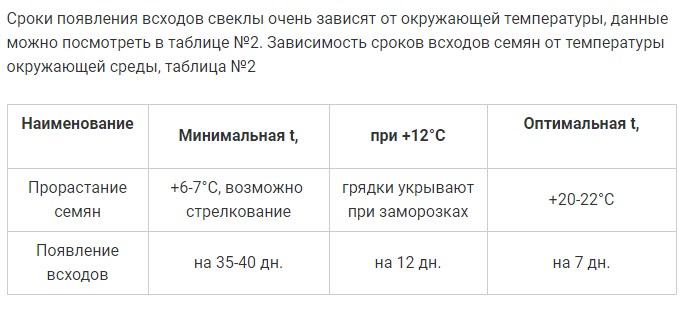
Growing seedlings of beets
- If you grow early beets, a seedling method is suitable. Give preference to varieties that are resistant to flowering. For these purposes are suitable "K-249" and "Cold-resistant-19".
- Growing seedlings are carried out 21 days before the alleged landing in a permanent place. First, the seed is soaked in the solution potassium permanganate, And they germinate for 3 days in a piece of wet fabric. After the seeds are placed in small containers or plastic glasses. Containers need to be filled with nutrient soil, processed "Fitosporin". Deepen the seeds by 2-3 cm, and put the containers in the greenhouse. You can also plant seeds in a greenhouse, observing the landing scheme 5x3 cm.
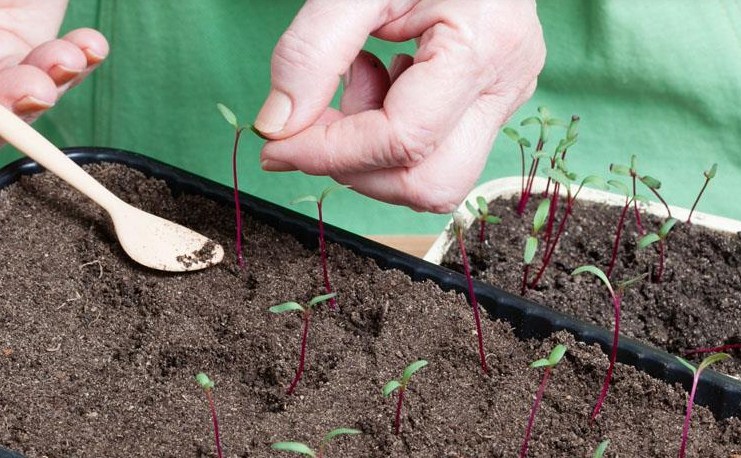
- To form high -quality beet seedlings, it is necessary to provide her with full -fledged care. Follow optimal humidity and temperature regime. Also ventilate the greenhouse so that the plants receive the required amount of air.
- If you have grown seedlings in common containers, you need piking. If the seeds were placed in separate containers or glasses, plants do not need diving. They can be immediately planted in a permanent place. Proceed to transplant should be formed when 2 pairs of leaves.
Scheme and features of spring planting beets
If you decide to start planting beets in the spring, adhere to the following instructions:
- Make furrows about 2 cm deep. The distance between them should be about 25 cm.
- Fertilize.
- Pour the furrows with a small amount of warm water.
- Place the seeds inside, observing the distance 15 cm from each other.
- Pour the furrows with soil mixed with peat.
- Lamp a little soil. Water landings once every 2-3 days.
- If there is a risk of returning frosts, cover the beds with a film. Remove the shelter in the afternoon, and by the evening, cover again.
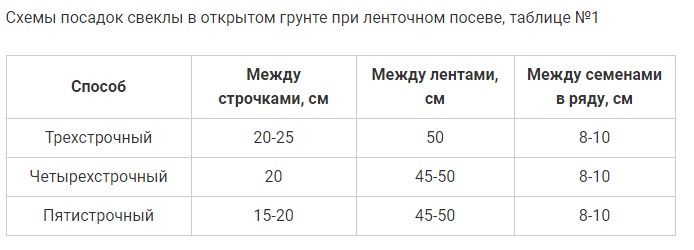
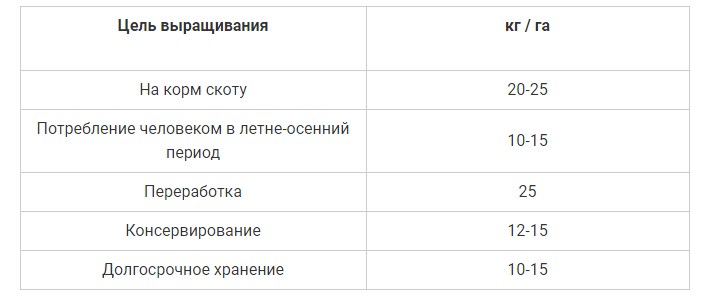
Scheme and features of autumn planting beets
- If you plant beets in the fall, pick up the bed. It is better if it is on a hill, so that meltwater does not wash the seeds from the ground in the spring. Choose well -lit areas.
- Preparing the place for planting beets is to dig the soil, and the removal of weeds. Bring potassium, phosphorus and wood ash. It is better to plant beets in the fall in November.
Sowing instructions:
- Make furrows, depth of about 3 cm. A distance of 20 cm should be observed between them.
- Place the seeds in the furrows, observing a distance of 10-13 cm. Pour them with a nutrient mixture. To do this, mix the soil with humus, compost and peat, in the ratio 2:1:1:1.
- Pour the beds coniferous branches or fallen leaves. Such a shelter will protect the seed from frosts.
- With the onset of spring, plant shelter should be removed and pulled over polyethylene film.
- When the first shoots appear, the film can be removed.
How to leak beets?
- How to leak beets? It is important to observe the optimal distance between rows and plants. Therefore, the care should consist in thinning the beds. If you notice weak and small sprouts, they should be removed. This is necessary that developed plants receive a sufficient amount nutrients, light and moisture.
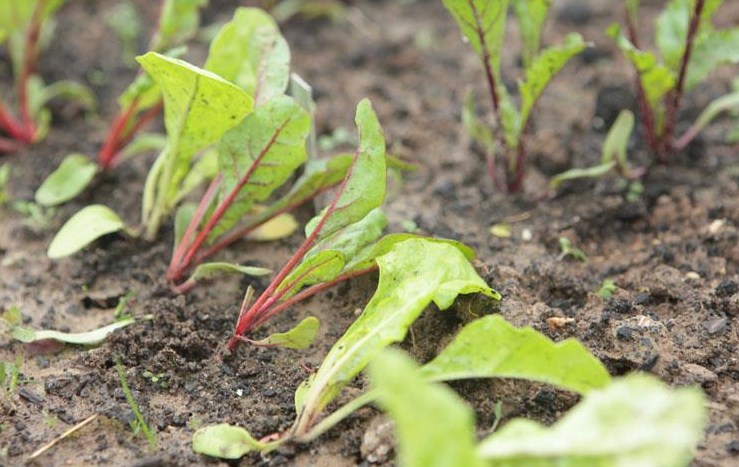
- If you do not want to thin out the beds, you can plant a beet variety "Single". It forms nozzles of 1-2 sprouts.
- The first time you need to thin out the beds 2 weeks after the appearance of the sprouts. Between plants, they leave a distance 3-4 cm. The second time - when it is formed 3 pairs of leaves. Now you need to increase the distance between the bushes to 10-15 cm. If necessary, the third thinning is carried out in August. It is required if the root crops have grown quite a lot and interfere with each other.
- Try to plant beets next to stunted crops. It is important for her to receive a sufficient amount of sunlight. Very good to plant beets nearby with onions, cabbage, legumes, herbs, radish, tomatoes, cucumbers and strawberries.
You can not plant a culture next to:
- mustard;
- potatoes;
- garlic and spinach.
Features of beet care after planting
If you make a proper planting of beets, the first shoots will appear quite quickly.
After that, it is necessary to ensure full -fledged care, which is as follows:
- Watering. After the first thinning, you need to water the beets. Standard irrigation interval - once a week. If you live in the region with an arid climate, water the beds 2-3 times a week, as the soil is drained.
On 1m 2 You need to use 10 liters of water. When the culture grows, the water rate can be increased 1.5-2 times. 1.5 weeks before harvesting, stop watering so that it is easier to collect products.
- If you used fertilizers during landing, you need to conduct top dressing. Making nutrients is recommended 2-3 times per season. During the first top dressing, a mixture of chicken and mullein is used. It is necessary to dilute 10 kg of fertilizers in 10 liters of water, insist 1.5 weeks.
- Dilute the solution with water in the ratio 1:10Add 1 g of boric acid, and do the root top dressing of beets. Often prepared a solution of 30 g of nitroammophosics and 200 g of wood ash, which should be diluted in 10 liters of warm water.
- Repeated top dressing is carried out 2 weeks after the third, using superphosphate and potassium nitrate. The third time they are applied to fertilizers when it closes between the rows boat. This time use superphosphate and potassium nitrate.

The best varieties of beets for open ground
- For growing on the site are suitable dining rooms, fodder and sugar varieties of beets. You have the right to choose the variety that suits you based on the application of culture. if you have livestockGrow fodder beets. Sowing material must be disinfected and planted in fertile soil. Landing scheme - 60x25 cm.
- If you are going to cook food from beets, grow a dining room. To make the productivity indicators high, a well -lit area will be required. If you plant sugar beets, choose fertile and well -lit areas.
If you live in the region with a cold climate (Leningrad region and Siberia), such varieties are suitable - Kupchikha, ordinary miracle and cold-resistant-19. They are characterized by high yield indicators, resistance to frost, diseases and pests.
The best varieties of beets for the Moscow Region:
- Red ball. Early beet variety. The fruits of a rich burgundy shade, rounded. The skin is smooth. There are no rings with a cut;
- Detroit. Early variety. Fruits of medium size, with high taste. The ripened beets is characterized by burgundy color, there are no stripes on the cut. The average weight of one fetus is 200 g;
- Mulatto. Early variety characterized by high yield indicators. Fetal weight - from 300 to 400. Suitable for long -term storage;
- Bordeaux. Late variety. Rooted roots are rounded, saturated burgundy shade. The average weight of the fetus is 350 g;
- Cylinder. Variety with late ripening dates. The fruits are red, cylindrical. Their length is about 15 cm. It is characterized by resistance to diseases, and is suitable for long -term storage;
- Mona. Late variety.
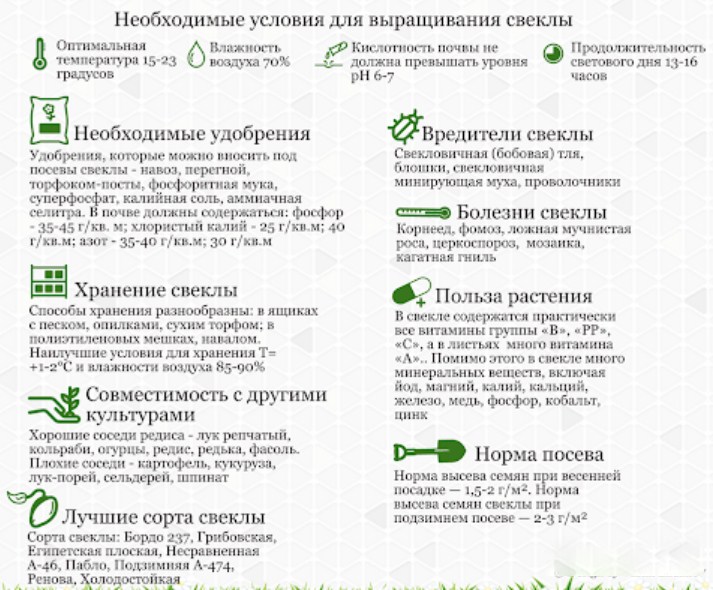
As you can see, there is nothing complicated in the cultivation of beets. It is recommended to add quite ordinary nutrients to the holes. Compliance with all of the above recommendations increases the likelihood of collecting large and juicy root crops.
Topics for gardeners - what they put in a hole when landing:







